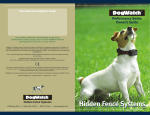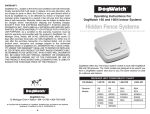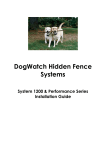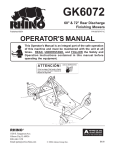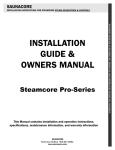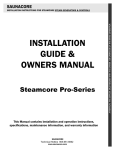Download DogWatch Hidden Fence System Specifications
Transcript
O pe r a t i n g I n s t r u c t i o n s f o r D o gWa t c h® Sys t e m 1200 ................................................. R1200 Receiver R1200m R1200 Contact Posts Adjustable Nylon Collar Metal Lock Washer CollarBone Test Light Insert battery NEGATIVE end down. Battery Cap Insert battery POSITIVE end down. Figure 2 Magnet 3.6 Volt Battery (R1200) Hold Magnet Between Two Lines The lightweight radio receiver worn by the dog identifies a coded FM radio signal from the boundary wire. The receiver emits an audible warning followed by a correction stimulation if the dog comes too close to the boundary wire. The R1200 operates on a replaceable battery and is waterproof when the battery cap is fully seated. System 1200 Receiver Features Adjustable Collar: The receiver is attached to an adjustable nylon collar. The collar should be positioned above the dog’s regular collar. Your DogWatch dealer will adjust the collar to insure that the contact posts touch the skin on the dog’s neck. (Figure 1.) Check Figure 1. the fit for the first few days of wear to insure that the collar is not too tight or causing irritation to your pet’s neck. It is strongly recommended that you remove the collar at night while your pet is inside. Contact Posts: Your DogWatch dealer will determine the correct set based on your dog’s neck shape, coat, and skin sensitivity. The posts must make contact with the skin in order for the dog to feel the stimulation. In certain cases, it may be helpful to clip some of the hair around the contact posts so that the posts can touch the skin more easily. Tighten the contact posts only with the collar wrench provided. Use of pliers or similar tools can result in over-tightening, which can damage the receiver. Antenna: The receiver incorporates an omni-directional antenna design. The use of multiple antennas in the receiver assures optimal reception from the signal field. R1200m Battery: The R1200m receiver is powered by a 3 volt (1/3 N) lithium battery. The receiver is designed for a battery life of up to 6 months. The negative (-) end of the battery must be inserted down. (Figure 2) R1200 Battery: The R1200 battery is powered by a 3.6 volt lithium battery. The receiver is designed for a battery life of up to two years. The positive (+) end of the battery must be inserted down. (Figure 3) -2- Figure 3 Battery Plans: Ask your DogWatch Dealer about a battery plan. If your DogWatch Dealer does not offer a battery plan, you can join the DogWatch Battery Program, where a new battery is mailed to you every 6 or 24 months, depending on the type of receiver you own. Call DogWatch at 800-793-3436 or join through the website at www.dogwatch.com. Test Ligh t: The test light allows you to test the receiver. Hold the test light over the contact posts. (see illustration at left). and carry the receiver into the signal field. When the receiver picks up the signal from the boundary wire, the audible warning will sound and the test light will come on. Au t o m at i c Sh u t do w n : The DogWatch system is designed to protect your dog from an over-correction in the unlikely event that your dog walks into the signal field. If your dog does not exit the signal field, the receiver will automatically stop correcting after 15 seconds – protecting your dog from over-correction. The dog will also receive a “warning” correction every 15 seconds which will continue until he leaves the field. R e c o m m e n d e d R e c e i v e r Se t t i n g s System 1200 incorporates 4 training levels plus an audible only setting. Level 1 is a very low correction setting that in many cases is an appropriate training level for timid pets. Levels 2 and 3 are progressively stronger training levels. Level 4 is designed specifically for pets that require higher correction levels in order to be contained. Your DogWatch dealer will set the receiver to the appropriate training level for your pet. All settings are designed to be Pet Friendly™ and will not harm your dog. To change the setting of the receiver, hold your test light magnet to the end seam of the receiver between the two raised lines on the side of the receiver (as shown on page 4). Hold the magnet steady and you will hear a series of beeps as the Training Level advances. The Training Level will continue to advance as long as the magnet is held in position, advancing to Training Level 1 (Low: 1 beep); Level 2 (Medium: 2 beeps); Level 3 (Medium High - three beeps) and Level 4 (High: 4 beeps). The beeps represent the Training Level the receiver is set to. When you reach the desired Training Level setting, pull the magnet away from the receiver. The receiver is now set. Not e: Any time the magnet activates the receiver, it will advance the receiver setting to the next Training Level, and continue to cycle through the settings in the order shown in the table below, as long as the magnet is held in place. -3- Co nt ai nm en t Tr ai ni ng This section covers the phases necessary to teach your dog to remain within the designated boundary of your property by teaching you how to teach your dog, so it is important that you understand each phase completely. Using the test light magnet to reset the R1200m Receiver Using the test light magnet to reset the R1200 Receiver Mult iple D ogs The System 1200 allows you to select a different training level for each dog – allowing you to conduct training with one dog, for example on Level 1, while the other dog is protected with Level 2. Training Level Audible Only Level 1 Level 2 Level 3 Level 4 To n e O n e L o n g Be e p 1 be e p 2 be e p s 3 be e p s 4 be e ps C or r ect i on L evel No n e Lo w M e di u m M e di u m -H i g h Hig h Cr e a t in g Th e R i gh t E n v i r o n m e n t Attitude and Consistency is Important! 1. 2. 3. 4. 5. 6. 7. 8. 9. Keep the training “light”. Use lots of praise. Keep the dog’s spirits high. Use high happy tones for praise. Use low tones for negative commands. Move around the boundary in the same direction. Reinforce the boundary with commands. Use the commands “Watch Out!” or “Careful” as you slap or shake the flags. Limit the training session to no more than 20 minutes. Keep your dog on the lead in the yard for five days. If you are training more than one dog, train each dog separately. Use naturally occurring distractions such as a neighbor or children. Contact your DogWatch Dealer if you have any questions. Ho w Th e D o gWa t ch Hi dde n Fe n c e Wo r k s: Think of the property having two distinct zones: Bo u n d a r y W i r e Syst e m 1200 Tr a n sm it t e r Fe a t u r e s Av o i da n c e Z o n e R an g e +/ -: The radio signal is transmitted from the boundary wire in all directions. The signal is adjusted by the range control on the transmitter to create a signal field on each side of the wire. Your DogWatch dealer will adjust the range accordingly. The range control is very sensitive. If you make an adjustment, be sure you check the actual signal range before letting your dog out. Your dog will receive a correction when entering the signal field. Neve r a dj u st t h e si g n a l r an g e w h en yo u r do g i s w ea r i n g t h e r ec ei ver co l l ar. Sa f et y Zo ne D ogWa t c h Syst e m 1200 Figure 4. Si g n a l R an g e Co n tr ol O n / O f f Sw i t c h L oo p Pl u g Po w e r S u pp l y 1. SAFE T Y Z O NE : This is the area where the dog is free to play. (Figure 4.) 2. AV OI D ANCE Z ONE : This is the signal field created by the boundary wire. When your dog crosses the signal field, the receiver collar emits an audible warning followed by a correaction. When containment training is complete, your dog will remain in the Safety Zone. Adj u s t in g t h e Re ce i ve r C ol l ar Gr o u n d W ir e - 4- Your DogWatch Dealer has installed your DogWatch Hidden Fence System, set the transmitter and receiver to the training levels appropriate for your dog’s personality, and has placed boundary flags around the perimeter of your yard. Your Dealer has already begun your dog’s first day of containment training. Now it is your turn to continue the training. -5- Adj u st i n g T h e Re ce i ve r PHA SE 1 (1-2 da ys) Before you begin containment training with your dog, be sure to place the DogWatch receiver collar on your dog’s neck before you go outside. Au di bl e or “ Bee p” Tr a i n i n g During this phase, your DogWatch Dealer has turned off the Mode switch on the transmitter and correction rate on the receiver. Your dog will hear only an audible “beep” tone and will not receive a correction during this phase. 1. The collar should be worn snugly on the dog’s neck. T h i s is e xt re m el y i m po r t a n t ! 1. Put the receiver collar on your dog 20 minutes before training. Your dog’s regular collar should be positioned below the DogWatch collar. 2. Place no more than one thumb width between the contact post and dog’s neck. 2. Clip the green DogWatch training lead on his regular collar. 3. When checking snugness of collar, the dog’s neck should be facing down (sniffing position) as this is where the dog’s neck is the smallest. (Figure 5). 3. Take your dog outside and play with him in the Safety Zone for a few minutes. 4. Walk your dog around the perimeter of your yard, keeping inside the Safety Zone and away (about 3 to 4 feet) from the training flags. 4. If the collar is too tight, the receiver unit will stick out to the side when the dog shakes his head. 5. If the collar is too loose, the dog will not receive the intended correction when he or she wanders into the Avoidance Zone. (Figure 6). 6. Remember to periodically check for irritation around the dog’s neck. 7. DogWatch st r on g l y recommends that the collar be removed daily when the dog is inside the house. Beg i n Con t ai n m en t Tr ai n i n g 5. When you finish the walk, approach a training flag. Hold the dog by the leash in one hand and slap or shake a flag with the other, warning the dog firmly (in a low stern voice) “Watch out! or “Careful!” (Figure 8.) You can also use a friend or family member to sit in the Avoidance Zone to slap or wave the flag as you approach the flags. Figure 5. Ad ju st collar s tr a p Figure 6. Con t act Po s ts mu st tou ch sk in 6. Give a leash (tug) correction, and quickly retreat into the Safety Zone. This creates a sense of urgency to the retreat. It is not a casual turn. Remember to use of lot of “Good dog!” praise after you’ve retreated into the Safety Zone. 7. Now walk your dog around the property allowing him to enter the Avoidance Zone between the two flags. Figure 8. Purpose: To teach your dog where the boundary is and how to react to it. 1. Only a portion of the yard, the Avoidance Zone, is to be avoided. 2. Playtime is very important! Remember to reinforce the Safety Zone and play with your dog before, during, and after each training sessions. (Figure 7) 3. Never throw a ball or toy into the Avoidance Zone during training. 4. There are 6 phases of training. Your DogWatch Dealer will begin containment Figure 7. training on the audible “beep” tone, Level 1 or Level 2, depending on your dog’s breed and personality. Your Dealer will work with you and your dog to insure your understand the training phases and at what phase you should continue training. 8. When your dog enters the Avoidance Zone, he will receive an audible “beep” warning. Immediately yell, “Watch out!” and quick ly tug on the leash and direct him back into the Safety Zone and praise (Figure 9.) 9. Repeat several times in different locations (where flags are visible) and watch for hesitation as you approach the flags. Your dog may turn or shake his head when he hears the beep. Re me m be r : P la y t im e i s v e r y i m p o r t a n t ! Praise and play with your dog in the Safety Zone for a few minutes. Take your dog inside and remove the DogWatch receiver collar after about 20 minutes. Train your dog in this manner for a least two days before moving onto Phase 2. 5. If you have questions about containment training, please contact your DogWatch Dealer for assistance. -6- Figure 9. -7- PHASE 2 ( 2-5 da ys ) PHA SE 3 (c o nt in ue d) end the exercise and praise your dog in the Safety Zone. I n t r o du c t i on t o Co r r ec t i on 1. Put the DogWatch receiver collar on your dog at least 20 minutes before going outside to train. 8. Repeat the exercise for 2 to 5 days. Then move to Phase 4. 2. Clip on the green DogWatch training lead and take your dog outside and play a few minutes in the Safety Zone. PHA SE 4 ( 2-5 da ys) 3. Walk around the complete perimeter, remaining inside the Safety Zone. Pause a few times along the way to slap a flag and yell, “Watch out!” or “Careful!” 4. Select a new location to teach your dog today. Allow your dog to walk into the Avoidance Zone while saying the negative command. If your dog retreats out of the Avoidance Zone when he hears the warning “beep”, praise him for a few minutes in the Safety Zone. 5. Select another location and repeat the exercise. Remember: Keep the training sessions to no longer than 20 minutes, once or twice a day. 6. After training, praise your dog and play with him in the Safety Zone for a few minutes, bring your dog into the house and remove the DogWatch collar after about 20 minutes. Note: It is important not to remove the receiver collar immediately following the training as you do not want your dog to associate the receiver collar with the correction. PHASE 3 ( 2-5 da ys ) I n t r o d u c t io n t o I n c r e a s e d D i s t r a c t i o n s 1. Put the DogWatch receiver collar on your dog at least 20 minutes before going outside to train. 2. Clip on the green DogWatch training lead to your dog’s regular collar and take him outside. Play a few minutes in the Safety Zone. 3. Reinforce the flags. 4. Introduce “real life” distractions to your dog. Have a friend drop by or start training when the letter carrier or school bus is scheduled. Take extra care if you use a vehicle as a distraction. (Figure 11.) 5. Keep the dog on leash when you first introduce the distraction. If your dog attempts to run past the flags and receives a correction, he should retreat to the Safety Zone. Praise and play with your dog. 6. If your dog is afraid to move, tug him back into the Safety Zone. Continue to train with distractions for 2 to 5 days. I n t r o du c t i on t o D i st r ac t io n s 1. Put the DogWatch receiver collar on your dog at least 20 minutes before going outside to train. Remember: Play and praise at the end of each training session. Figure 11. 2. Clip on the green DogWatch training lead and take your dog outside and play a few minutes in the Safety Zone. 3. Walk around the Safety Zone and have an assistant (friend or family member) appear outside the Safety Zone at least 10 to 15 feet back from the flags. Walk past your assistant without speaking, but remain in the Safety Zone.(Figure 10.) PHA SE 5 ( 2-5 da ys) Figure 10. 4. If your dog approaches your assistant and enters the Avoidance Zone, allow your dog to receive a correction. Yell, “Watch out!” and tug him back into the Safety Zone. 5. Let your assistant leave, walk your dog around the perimeter again, and let your assistant appear again. Your assistant can call out the dog’s name, but do not allow your assistant to ask the dog to “Come”. L et t i n g Yo u r D og Off T h e L e as h 1. Put the DogWatch receiver collar on your dog at least 20 minutes before going outside to train. 2. Clip on the green DogWatch training lead to your dog’s regular collar and take him outside and play a few minutes in the Safety Zone. Remove the training leash and let him run freely in the yard. Shake the flags to reinforce where his boundary is. 3. I mpo r t a n t : Your dog will expand his comfort level over a period of time. Your dog should remain about 6 feet way from the flags when he is first let off the leash. Gradually your dog’s safety zone will increase to his individual level of comfort. Remove the flags, every other one, every other day. Wh at To E xpe ct O ff L e as h 1. Your dog will run toward the flags, see them and stop. 6. If your dog attempts to go over to your assistant, reinforce the flags and yell. “Watch out!” Repeat the exercise for no more than a total of 20 minutes. 2. Your dog will run into the system, hear the “beep” warning and retreat. 7. If your dog makes no attempt to go over to your assistant, reinforce the flags, 3. Your dog will run into the system, hear the “beep” warning, receive a correction, and retreat. -8- -9- Tr ain ing T i ps 4. In rare cases, your dog will run through the boundary. 1. Never call your dog to “come” or give a recall command when you are outside the flag line. 2. Never take your dog for a walk outside the system during the training process by walking through the flags. 3. Always reinforce the retreat concept by shaking the flag while saying “Watch out!” and commanding “back-back-back-” when your dog receives an audible warning or a correction during the training process. Tro uble sh o o ti ng Que st io n s Important Reminders: • • • • • - Bring the dog into the house and call your DogWatch Dealer. Additional flag training or an increase in correction level is necessary. Your DogWatch dealer will instruct you over the phone or meet with you and your dog for additional training. Important: Do not punish the dog verbally for making errors. He’s still learning! PHASE 6 ( 2-5 da ys) Question: My dog is afraid to come off the porch after a day or two of training. What should I do? Answer: Walk your dog around the boundary so he knows where the Safety Zone is. Don’t force your dog to go up to the flags if he hesitates. Each day he’ll get closer to the boundary line and flags. When he goes closer to the flags, slap the flag and yell. “Watch out!” Retreat to the Safety Zone and praise and play. Question: My dog will not come out of the house. I don’t want to drag him outside. What can I do? Answer: Refrain from training today. Take your dog outside and play with him in the yard until he feels comfortable again. Resume training in a day or two. Contact your DogWatch dealer if you need assistance or if you have any questions about the training or your dog’s behavior. • • - Retrieve the dog. Take off the receiver collar and walk him back into the yard. Adjust the receiver collar and test the battery regularly. After the training period, your dog may wear the receiver collar during the day, but remove it at night. Check your dog’s neck area and make sure there is no irritation. Keep the training consistent: 15 to 20 minutes once or twice a day. Keep the contact posts clean. NEVER throw a stick or toy into the Avoidance Zone. ALWAYS maintain a positive attitude when training your dog. NEVER allow your dog to cross the boundary. Yo u r D o g ’s R es po n se To St im u l a t io n Stimulation has been a safe and effective part of dog training for over twenty years. All dogs respond differently when they feel a mild stimulation. Some dogs may demonstrate little, if any, reaction, while others may yelp or jump back. Some dogs “freeze”. Do not try to comfort the dog if he receives correction or it will reinforce his anxiety. Ta k in g You r D o g Ou t s ide Th e Bou n da r y Your dealer will recommend when it is time to take your dog across the boundary for a walk. It is important to be consistent when taking your dog for a walk. Be sure to use your dog’s regular collar and leash and go to and from your walk using the same “exit” area. You can also pick up a small dog and carry him over the flagged boundary during the first weeks of training. Tr a i ni ng Ti ps 1. Never call your dog to “come” or give a recall command when you are outside the flag line. 2. Never walk your dog through the flags during the training process. 3. Always reinforce the retreat concept by shaking the flag while saying “Watch out!” and commanding “back-back-back-” when your dog receives an audible warning or a correction during the training process. 4. Adjust the receiver collar, test the battery regularly, keep the contact posts clean. 5. After the training period, your dog may wear the receiver collar during the day, but remove it at night. Check your dog’s neck area and make sure there is no irritation. 6. Keep the training consistent: 15 to 20 minutes once or twice a day. 7. NEVER throw a stick or toy into the Avoidance Zone. 8. ALWAYS maintain a positive attitude when training your dog. D o g Per s on al i t ie s a n d Tr a it s Keep in mind that a dog’s personality and traits differ among breeds. Dogs may not exhibit the same personalities and traits within the same breed. Your DogWatch dealer will ask you questions about your dog before training begins. A shy or senior dog may require longer Phase 1 sessions, while a gregarious or easily distracted dog may require a short Phase 1, but longer Phase 2 or 3 sessions. The better you know your dog, the easier the training will be for both of you! - 10 - - 11 - N OT E S I MPO RTA NT SA FE GUA R DS D og Wa t c h D e a le r Na m e * * * I MPORTA NT * * * DOGWAT CH ST R ONGLY R ECOM ME ND S T HAT YOU R EM OVE T HE COL LA R AT NI GHT WHILE T HE DOG IS INSI D E. P h o n e N u m be r ( s ) • Please read all the literature included with your DogWatch® Hidden Fence System before turning the system or or beginning training. • Do not attempt to shortcut the complete training of your dog. • The DogWatch Hidden Fence System is intended for the purpose of containing domestic dogs. Use it for any other purpose is at system owner’s risk. • In the event your system requires servicing, please contact your local Authorized DogWatch Dealer. Attempting to service the system yourself may invalidate the warranty. To c o n t ac t yo u r l o ca l dea l er, pl ea se ca l l D o g Wa t ch I n c . C u st o m er Ser vi c e a t : 800-793-3436 or g o t o o u r Web Si t e at w w w.do g w a t ch .co m a n d c l i c k o n “ L o c a t e D e a l e r ”. • Keep the transmitter and receiver collar out of reach of children. • Place the receiver collar on the dog so that the battery cap faces downward. • Fit the collar snugly around your dog’s neck. • Make sure the battery is inserted correctly - POSITIVE END DOWN! • Never adjust the transmitter when your dog is wearing the collar • Although System 1200 contains built-in protective circuitry to reduce damage from a lightning storm or power surges, it is recommended that you unplug your transmitter from the wall outlet and disconnect the loop wire during lightning storms, or when it is unused for extended periods. • This product is only intended for with trained domestic dogs. If your dog is aggressive or violent and could cause harm to itself or others outside the fenced premises, you should take other measures to restrain your dog such as traditional fencing. - 12 - - 13 - War r a nt y R eg i s tr a t io n How The Dogwatch System Is Installed Your Warranty Registration card must be complete for your warranty to be activated. Fill out the enclosed Warranty Registration card and mail back to DogWatch within seven (7) days. For your convenience, you can also complete your warranty registration on line at www.dogwatch.com. M an uf a ct ur e r ’s Wa r r a nt y 1. WARR ANTY: DogWatch Inc., subject to the terms and conditions set forth hereunder, hereby warrants that it will repair or replace, at its own discretion, without charge for parts or labor, the Product or any part thereof (other than insulated wire) which is found by DogWatch Inc. to be defective by reason of improper workmanship and/or materials for the warranty period from the original date of sale hereunder. Warranty claims may be subject to dealer service charges and/or manufacturer shipping and handling charges. EXCEPT FOR THE EXPRESS WARRANTY STATED ABOVE, DOGWATCH INC. DISCLAIMS ALL EXPRESS AND IMPLIED WARRANTIES OR MERCHANTABILITY OR FITNESS FOR A PARTICULAR PURPOSE. As a condition of this warranty, Customer must (a) mail the warranty card provided with the product to DogWatch Inc, 10 Michigan Drive, Natick, MA 01760, (800) 793-3436, or complete warranty registration on line at www.dogwatch.com, within seven (7) days after purchase hereunder, (b) notify DogWatch Inc. within the warranty period after the purchase hereunder of a claimed defect, and (c) mail product back, insurance and postage prepaid, to DogWatch Inc. at the address above. DOGWATCH INC.’S SOLE LIABILITY UNDER THIS WARRANTY WILL BE TO REPAIR OR REPLACE, AT ITS OPTION, ANY PRODUCT OR PART WHICH DOGWATCH INC. DETERMINES TO BE DEFECTIVE. IN NO EVENT WILL DOGWATCH INC. BE LIABLE FOR ANY SPECIAL, INDIRECT, OR CONSEQUENTIAL DAMAGES ARISING OUT OF THE PURCHASE OR USE OF THE PRODUCT. IN NO EVENT SHALL DOGWATCH INC.’S LIABILITY EXCEED THE PURCHASE PRICE OF THE PRODUCT. 2. DE ALER -I NSTALL ED WARRA NTY: Any transmitter installed by an authorized dealer, equipped with a DogWatch Lightning Surge Protector and grounded to Dogwatch Inc. specifications, will be warrantied for as long as the owner owns the system.The R-1200 receiver carries a lifetime warranty. For this additional coverage to be in effect, the installing Dealer and Customer must sign the Customer Order Form and forward it to DogWatch within seven (7) days of purchase. Inside Wall Transmitter Surge Protector Power Supply Zip Cord Ground Wire Ground Wire Twisted Wire Boundary Wire 3. I NSTALL ATION AND MAINTENANCE: Dealer shall, for a non-refundable installation fee, install the Product in accordance with DogWatch Inc.’s installation manual. In no event shall Dealer or DogWatch Inc. be responsible for damage to underground pipes, wires, lines, or other items, nor shall Dealer or DogWatch Inc. be responsible for restoring Customer’s premises to its original condition. 4. WARNI NG: YOU MUST TRAIN YOUR DOG IN ACCORDANCE WITH THE TRAINING MANUAL FOR THIS SYSTEM TO BE EFFECTIVE. THE SYSTEM IS NOT INTENDED FOR USE WITH DOGS WITH A HISTORY OF AGGRESSIVE BEHAVIOR. BY SIGNING THE DEALER ORDER FORM, CUSTOMER ACKNOWLEDGES THAT THEIR DOG(S) HAVE NO SUCH HISTORY. THE PRODUCT WILL NOT KEEP ALL DOGS WITHIN THE FENCED PREMISES IN ALL INSTANCES. IF CUSTOMER’S DOG(S) COULD CAUSE HARM TO ITSELF OR OTHERS INSIDE OR OUTSIDE THE FENCED PREMISES, CUSTOMER SHOULD TAKE ADDITIONAL MEASURES TO RESTRAIN THE DOG(S). - 14 - Outside Wall - 15 - Ground Rod DogWatch, DogWatch logos, Performance Series, and SafeLink are registered trademarks of DogWatch Inc. FastReact, AutoMemory, Pet-Friendly, PowerPak, Scoot, GroundsKeeper, HouseKeeper, It’s All About Your Dog, Surrounding Pets With Freedom Since 1990 and Simply The Best... No Getting Around It are trademarks of DogWatch Inc. The Consumers Digest logo and Best Buy Seal are registered trademarks of Consumers Digest and used under license. DogWatch products are protected under U.S. Patent numbers: 5,353,744; 5,465,687; 6,079,367; 6,360,698; 6,467,435; 6,575,120; 6,825,768 and D,491,481. This device complies with part 15 of the FCC Rules. Operation is subject to the following two conditions: (1) This device may not cause harmful interference, and (2) this device must accept any interference received, including interference that may cause undesired operation. DogWatch products are lead-free and compliant with the Reduction of Hazardous Substances (RoHS) initiative. ©2007 DogWatch Inc. All rights reserved. 295025 Rev. D 04-07 ® ® Hidden Fence Systems 10 Michigan Drive ■ Natick, MA 01760 ■ 800-793-3436 ■ www.dogwatch.com










